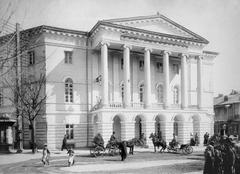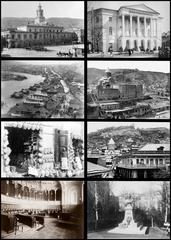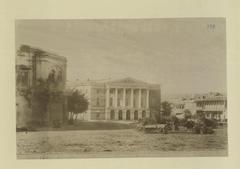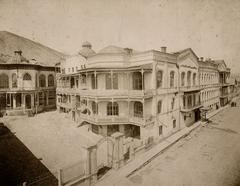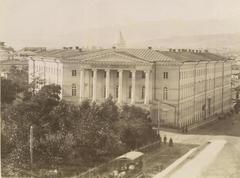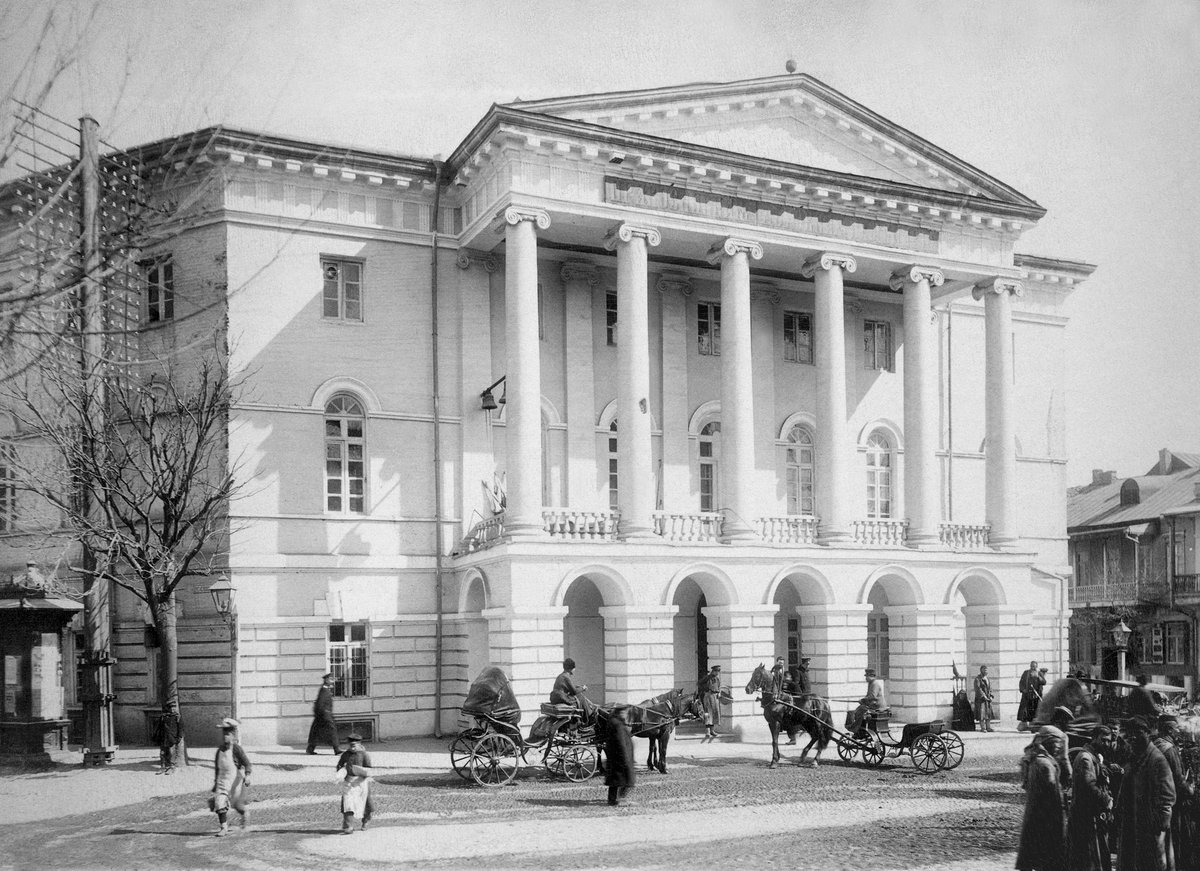
Art Museum of Georgia Tbilisi: Visiting Hours, Tickets, and Travel Guide
Date: 14/06/2025
Introduction: History and Cultural Significance
Nestled in the historic heart of Tbilisi, the Art Museum of Georgia—officially the Shalva Amiranashvili State Museum of Fine Arts—stands as a vibrant symbol of Georgia’s cultural heritage and artistic evolution. Established in 1920 during Georgia’s short-lived independence, the museum has become the Caucasus region’s leading art institution, boasting approximately 140,000 artifacts spanning Georgian, Oriental, Russian, and European traditions. Its collections include everything from medieval ecclesiastical masterpieces to exquisite goldsmithing, and works by iconic Georgian artists like Niko Pirosmani, Lado Gudiashvili, and David Kakabadze.
The museum’s history is deeply intertwined with Georgia’s national narrative, from the repatriation of the National Treasury after Soviet upheavals to its integration into the Georgian National Museum network in 2004. Housed in a neoclassical building from 1838, the museum’s architecture echoes layers of religious and cultural identity, creating a fitting backdrop for its priceless collections (SpottingHistory, Georgian National Museum official site, Tbilisi Local Guide).
Table of Contents
- Discover the Art Museum of Georgia: History, Collections, and Visitor Information
- Origins and Early Foundations
- Institutional Development and Expansion
- The Return of the National Treasury
- Architectural Evolution
- Integration into the Georgian National Museum Network
- Collections and Cultural Significance
- Role During Soviet and Post-Soviet Eras
- Research, Conservation, and Education
- Visitor Information: Plan Your Visit
- Legacy and Continuing Evolution
- Frequently Asked Questions
- Plan Your Visit and Stay Connected
- References
History and Collections
Origins and Early Foundations
The Art Museum of Georgia began as the National Art Gallery in 1920, founded by Georgian artists and intellectuals with a vision to preserve national art and culture. This establishment marked a cultural revival after centuries under foreign rule (SpottingHistory; Museum Studies Abroad).
Institutional Development and Expansion
In 1923, the Central Museum of Fine Arts opened, expanding the collection and emphasizing the safeguarding of Georgian heritage post the 1921 Soviet annexation. By 1932, the museum moved to the Metekhi church site, symbolizing the blend of spiritual and artistic traditions (SpottingHistory).
The Return of the National Treasury
A turning point came in 1945 when Georgia’s National Treasury—manuscripts, metalwork, jewelry, enamels, and paintings—was returned from France, where it had been kept safe by the government-in-exile post-1921. This repatriation enhanced the museum’s collection and reinforced national pride. Shalva Amiranashvili, a key figure in Georgian art history, oversaw the process, and his legacy lives on in the museum’s name (SpottingHistory).
Architectural Evolution
Since 1950, the museum has occupied a neoclassical building originally built as a theological seminary in 1838. Its grand façade and interiors are a fitting home for the nation’s premier art collection. Recent renovations have modernized the museum, enhancing accessibility and visitor experience while preserving its historical character (Tbilisi.com.ua).
Integration into the Georgian National Museum Network
In 2004, the museum became part of the Georgian National Museum (GNM) network, which unified several major cultural institutions under one administration, fostering collaboration and expanding research and educational programming (SpottingHistory).
Collections and Cultural Significance
The museum’s diverse holdings include Georgian icons, frescoes, manuscripts, metalwork, and significant Oriental (notably Persian), Russian, and European art. The medieval Christian art collection is especially significant and reflects the influences of Byzantine, Persian, Ottoman, and Russian cultures (Museum Studies Abroad, The Art Bog).
During the Soviet era, the museum preserved Georgian art under restrictive conditions. Today, it plays a vital role in reinforcing national identity and reconnecting citizens with their heritage.
Research, Conservation, and Education
The museum is also a center for research and conservation. Its scientific departments collaborate internationally, and education programs engage everyone from students to scholars (Tbilisi.com.ua).
Visitor Information: Plan Your Visit
Visiting Hours
- Tuesday to Sunday: 10:00 AM – 6:00 PM
- Closed: Mondays and public holidays
Ticket Prices
- Adults: 10 GEL
- Students & Seniors: 5 GEL
- Children under 12: Free
Accessibility
- Wheelchair accessible, with ramps and elevators
- Accessible restrooms and parking
- Tactile relief copies and audio descriptions for visually impaired visitors
Guided Tours
- Offered in Georgian, English, and Russian
- Advance booking recommended
Special Events and Exhibitions
- Rotating exhibitions and cultural events throughout the year
- Free admission and special programming on International Museum Day (icom-georgia.mini.icom.museum)
Travel Tips
- Photography is allowed in most areas (no flash/tripods)
- Best to visit on weekday mornings for fewer crowds
- Combine your visit with nearby sites: Metekhi Church, Narikala Fortress, Rustaveli Avenue, Tbilisi Opera and Ballet Theatre
Best Photographic Spots
- Museum’s neoclassical façade
- Medieval art galleries
- Soviet Occupation Hall
Must-See Highlights
Georgian Art
- Medieval Ecclesiastical Art: Icons, mosaics, wall paintings, and artifacts like the Zarzma Icon of Transfiguration, Bedia Chalice, Anchiskhati Icon, and Queen Tamar’s Cross (Georgian Travel Guide)
- Goldsmithing & Jewelry: Cloisonné, filigree, and ceremonial objects (Tbilisi Local Guide)
- Works by Pirosmani, Gudiashvili, Akhvlediani, and Kakabadze: Tracing Georgian art from realism to modernism
Oriental, Russian & European Art
- Persian Qajar Art: Miniatures and portraits (Kalligone)
- Chinese, Japanese, Indian Artifacts: Ceramics, textiles, and decorative arts (Georgiaintrend)
- Russian Icons & Western Paintings: 18th–19th century works (Wikipedia)
Archaeological and Pre-Christian Artifacts
- Neolithic Clay Vessel: 6th millennium BC, evidence of Georgia’s winemaking legacy (Wander-Lush)
- Ioane-Zosime Manuscript: Among the earliest Gospel texts (Wander-Lush)
Facilities and Amenities
- Café “The Museum” and gift shop
- Research and conservation lab
- Cloakroom for small bags
- Audio guides and brochures in multiple languages
- Conference hall
- Parking for up to 155 vehicles
Frequently Asked Questions (FAQs)
Q: What are the Art Museum of Georgia’s visiting hours?
A: Tuesday–Sunday, 10:00 AM to 6:00 PM. Closed Mondays and public holidays.
Q: How much are tickets?
A: Adults 10 GEL, students/seniors 5 GEL, children under 12 free.
Q: Is the museum wheelchair accessible?
A: Yes, with ramps, elevators, and accessible facilities.
Q: Are guided tours available?
A: Yes, in Georgian, English, and Russian; book in advance.
Q: Can I take photos inside?
A: Yes, except with flash or tripods; check for signage.
Q: What other attractions are nearby?
A: Metekhi Church, Narikala Fortress, Rustaveli Avenue, and the Tbilisi Opera and Ballet Theatre.
Plan Your Visit and Stay Connected
Summary and Final Tips
The Art Museum of Georgia is a cornerstone of the country’s cultural identity, offering a comprehensive journey through its artistic and historical landscape. With modern facilities, accessible features, and a central location, it’s an essential stop for any visitor to Tbilisi. Plan ahead, use the official website for hours and tickets, and make use of guided tours for deeper insight.
For more information, visit:
References
- Art Museum of Georgia: A Complete Visitor’s Guide to History, Collections, and Practical Information, 2025, SpottingHistory (https://www.spottinghistory.com/view/8954/art-museum-of-georgia/)
- Art Museum of Georgia: Visiting Hours, Tickets & Cultural Significance in Tbilisi, 2025, Georgian National Museum Official Site (https://art.gov.ge/en/event/opening-of-the-shalva-amiranashvili-state-museum-of-fine-arts-of-georgia/)
- Art Museum of Georgia Visiting Hours, Tickets & Must-See Highlights in Tbilisi, 2025, Tbilisi Local Guide (https://tbilisilocalguide.com/tbilisi/georgian-museum-of-fine-arts/)
- Art Museum of Georgia: Visiting Hours, Tickets & Cultural Significance in Tbilisi, 2025, ICOM Georgia (https://icom-georgia.mini.icom.museum/en/3940/)
- Art Museum of Georgia: A Complete Visitor’s Guide to History, Collections, and Practical Information, 2025, Tbilisi.com.ua (https://tbilisi.com.ua/georgian-national-museum/)
- Discover the Art Museum of Georgia: Visiting Hours, Tickets, and Must-See Highlights, 2025, Georgian Travel Guide (https://georgiantravelguide.com/en/shalva-amiranashvilis-sakhelobis-khelovnebis-sakhelmtsifo-muzeumi)
